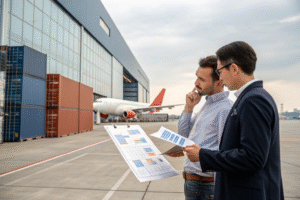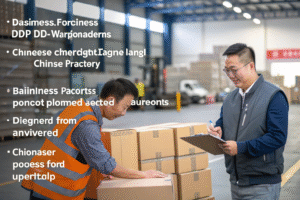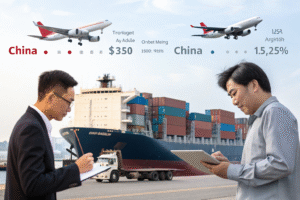When it comes to international shipping, choosing between air freight and sea freight isn’t just about time—it’s also about cost. Many businesses struggle to decide which method is more economical and how pricing actually works. At GeeseCargo, we help importers understand these cost dynamics so they can optimize their shipping strategies.
Air freight is significantly faster but costs more per kilogram, while sea freight is slower but far more economical for large or heavy shipments. The best choice depends on shipment size, urgency, and value.
Let’s break down how these two freight methods compare in terms of pricing, and when each is most cost-effective.
What Are the Core Pricing Models of Air vs. Sea Freight?
Understanding how rates are calculated is the first step toward comparing freight options accurately.

How Is Air Freight Priced?
Air freight is typically charged based on the chargeable weight, which is either the actual weight or the volumetric weight—whichever is greater. The volumetric weight is calculated using this formula:
Volumetric Weight (kg) = (Length × Width × Height in cm) ÷ 6000
For example, a lightweight but bulky box may cost as much as a dense item of the same dimensions. Prices often range from $4 to $10 per kg, depending on origin, destination, and service level.
Many international shippers rely on express services like DHL Express for urgent deliveries, but this drives the cost even higher.
How Is Sea Freight Priced?
Sea freight is mostly charged by volume—specifically in CBM (cubic meters). For Less than Container Load (LCL), the formula is:
1 CBM = (Length × Width × Height in meters)
Rates may start from $30 to $80 per CBM, but there are surcharges: fuel, terminal handling, customs, and security.
For full container loads (FCL), the pricing is per container—such as $1,200 for a 20ft and $1,800 for a 40ft from China to the US. See Freightos’ calculator for real-time comparisons.
How Do Transit Time and Costs Influence Decision-Making?
Transit time is one of the most important considerations when evaluating cost-effectiveness.

When Is Air Freight Worth the Cost?
Air freight is ideal when speed is essential: product launches, replacement parts, perishable goods, or high-value items. Deliveries typically take 3 to 7 days, including customs clearance.
For example, if you’re shipping $100,000 worth of electronics and need to meet a retail deadline, paying $8/kg to air ship 200kg might be a better investment than risking a delayed launch.
Even in non-urgent cases, seasonal demand spikes can make air freight more appealing than rolling the dice on port congestion.
When Should You Choose Sea Freight?
Sea freight is ideal for bulk orders, non-urgent stock replenishment, or goods with long shelf life. Transit typically takes 20 to 45 days, depending on route and congestion.
For example, fashion brands preparing winter inventory in summer can safely use sea freight to reduce shipping cost by up to 80% compared to air freight. Learn how seasonal logistics planning helps reduce shipping cost.
What Role Do Surcharges and Hidden Fees Play?
Base freight costs are only part of the equation. Each shipping mode comes with additional fees that impact the final landed cost.

What Extra Costs Are Common in Air Freight?
- Fuel surcharges: Adjusted monthly based on fuel index
- Security screening: Especially for sensitive goods
- Airport handling fees
- Customs brokerage and delivery
Some carriers also apply peak season surcharges. If you’re shipping in Q4 or pre-Chinese New Year, expect airfreight rates to jump 30–50%. Check IATA’s rate forecast to monitor pricing trends.
What Extra Costs Are Common in Sea Freight?
- Port charges and handling (THC, ISPS, documentation fees)
- Demurrage and detention if containers are delayed at port
- Warehousing and LCL consolidation charges
- Customs fees and inland haulage
Sea freight also carries higher insurance risks due to longer transit and cargo exposure. It’s important to factor in cargo insurance premiums and container seal inspection.
Which Mode Saves More for Different Business Types?
The right choice depends not just on the shipment, but on your business model and supply chain structure.

What Works for Small Businesses and E-Commerce?
E-commerce sellers often choose air freight for fast turnover and low storage costs. Small, high-value items like jewelry or accessories are perfect for air—even if shipping costs more per unit, faster delivery boosts customer satisfaction.
Dropshippers and Amazon sellers often use air express services to meet Prime expectations. Time is money.
What Works for Bulk Retailers or Manufacturers?
For large-volume importers—like furniture or textile wholesalers—sea freight is unbeatable. The per-unit cost savings allow for better margins, even if the planning timeline is longer.
Many B2B importers use hybrid strategies: air for urgent items or samples, sea for restocking. This balances cost and agility. Freight forwarders like GeeseCargo help develop flexible routes that shift based on inventory and sales cycles.
Conclusion
Air freight offers speed and reliability but at a higher cost per kilogram. Sea freight offers unbeatable economies of scale, but requires careful planning due to its slower timeline. The choice isn’t binary—many businesses use both to optimize their supply chains.
At GeeseCargo, we help clients weigh cost, urgency, and risk to build smarter logistics strategies. Whether you’re scaling fast or importing bulk, understanding freight pricing differences gives you a clear path to profitability.









